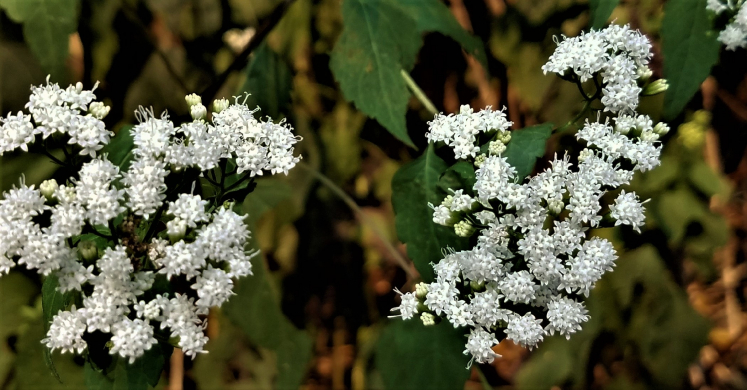Blog

#bioPGH Blog: White Snakeroot
 A resource of Biophilia: Pittsburgh, #bioPGH is a weekly blog and social media series that aims to encourage both children and adults to reconnect with nature and enjoy what each of our distinctive seasons has to offer.
A resource of Biophilia: Pittsburgh, #bioPGH is a weekly blog and social media series that aims to encourage both children and adults to reconnect with nature and enjoy what each of our distinctive seasons has to offer.
Oh the flowers of late summer! If you’ve suddenly noticed a 2 – 3-foot-tall plant with pointed leaves and small white flowers that almost look like tiny craft pom-poms, you’ve probably seen white snakeroot, which is just passing peak bloom right now. At Boyce Park this past weekend, the trails seemed to be lined with the little white flowers alongside the taller, more recognized goldenrod. Plants that flower this time of year are helpful for pollinators and other invertebrates whose food sources may be waning for the season, but white snakeroot does have a tricky side towards humans — let’s explore this native plant!
White snakeroot (Ageratina altissima) is a member of the Asteraceae family. If you remember a previous time that we talked about Asteraceae flowers, we mentioned how a single daisy or sunflower is actually many disk and ray florets clustered together. White snakeroots are entirely made of tiny disk florets — no ray florets like what appears to be the “petal” of a coneflower. The little white flowers will appear more “fluffy” now late in the bloom, but each teeny bit of fluff is actually an achene, the same kind of dry, fluffy seeds as a dandelion.
Though white snakeroot is native to eastern North American, it’s perhaps not as garden-friendly as other native plants due to its toxicity. White snakeroot is infamous as the culprit behind “milk sickness,” a significant issue in the Midwest during European settler expansion of the nineteenth century. Shortly after drinking milk, victims would begin trembling and experience intense gastrointestinal distress and often death — and it was noted that the livestock of a person suffering from milk sickness often had “the tremors” as well. The first documented description of milk sickness appeared in 1809, but in the 1830s, with the guidance of the Shawnee, Illinois doctor Anna Hobbs learned that cows and livestock ingesting white snakeroot could pass on the toxins from the plant in their milk. However, as she was a woman living in a remote area in the nineteenth century, it would have been difficult for her to spread this knowledge too far beyond her own community. In academic literature, credit is often given to a set of brothers who published the same conclusion in 1917.
Though we always want to encourage native plants, if you happen to find white snakeroot on your property near where kids play, mowing or pulling them early the season is your safest bet. Their roots do form tough, fibrous networks, but catching them they before they seed for the year will help prevent their future return in greater abundance.
Connecting to the Outdoors Tip: White snakeroot can be found in distrubed habitat and along the edges of more forested habitat - like along trails. Since the plant is bitter, it's not usually a preferred food item to animals that it can harm, but if you do suspect children or pets have ingested it, be sure to call Poison Control or the ASPCA's animal poison control.
Continue the Conversation: Share your nature discoveries with our community by posting to Twitter and Instagram with hashtag #bioPGH, and R.S.V.P. to attend our next Biophilia: Pittsburgh meeting.
Resources
Brooklyn Botanic Garden Weed of the Month: White Snakeroot
Illinois Wildflowers: White Snakeroot
OARDC - Ohio Perennial and Biennial Weed Guide: White Snakeroot

